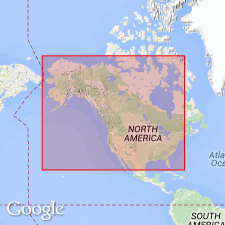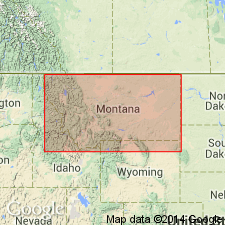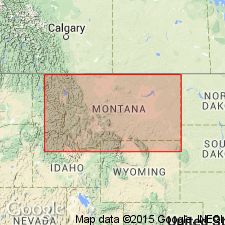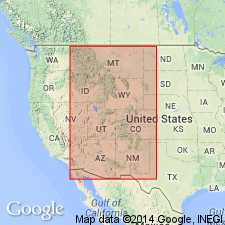
- Usage in publication:
-
- Deep Creek beds*
- Modifications:
-
- Original reference
- Dominant lithology:
-
- Clay
- Sandstone
- AAPG geologic province:
-
- Montana folded belt
Summary:
Pg. 287. Deep Creek beds. Still farther east [of Fort Ellis] along Deep Creek, exist remarkable lake deposits of both "Miocene" and "Pliocene" age, which represent TICHOLEPTUS beds of Cope. [Same as Deep River beds, the stream having been called by both names and also called Smith River.]
[See also †Smith River lake beds.]
Source: US geologic names lexicon (USGS Bull. 896, p. 586-587).

- Usage in publication:
-
- Deep River beds
- Modifications:
-
- Age modified
- AAPG geologic province:
-
- Montana folded belt
Summary:
Pg. 595. Deep River beds are upper Miocene. [See also Amer. Phil. Soc. Trans., v. 18, p. 55-63, and other reports of Scott.]
[See also †Smith River lake beds.]
Source: US geologic names lexicon (USGS Bull. 896, p. 586-587).

- Usage in publication:
-
- Deep River beds
- Modifications:
-
- Revised
- AAPG geologic province:
-
- Montana folded belt
Summary:
Pg. 150-151. Deep River beds restricted to what has previously been called Upper Deep River, and Fort Logan beds introduced for Lower Deep River. Faunas differ. Cope's collections of fossils all came from upper beds.
[See also †Smith River lake beds.]
Source: US geologic names lexicon (USGS Bull. 896, p. 586-587).

- Usage in publication:
-
- Deep River sequence
- Modifications:
-
- Age modified
- AAPG geologic province:
-
- Montana folded belt
Summary:
Pg. 76. "Upper part of Deep River sequence (Smith Creek) or TICHOLEPTUS zone of Cope," is middle Miocene, and (p. 65, 112) Fort Logan beds are lower Miocene.
[See also †Smith River lake beds.]
Source: US geologic names lexicon (USGS Bull. 896, p. 586-587).

- Usage in publication:
-
- Deep River formation
- Modifications:
-
- Areal extent
- AAPG geologic province:
-
- Montana folded belt
Summary:
Term preoccupied by an abandoned term of same name used by Emmons, but continued use as a Tertiary formation thought not to be confusing. Thought to be a synonym for Smith beds and Smith River beds. Shown on correlation chart as a Miocene unit of Barstovian or Sarmatian age, younger than Fort Logan formation and older than the Flaxville gravel. Used in Meagher Co, MT in the Montana folded belt province.
Source: GNU records (USGS DDS-6; Denver GNULEX).
For more information, please contact Nancy Stamm, Geologic Names Committee Secretary.
Asterisk (*) indicates published by U.S. Geological Survey authors.
"No current usage" (†) implies that a name has been abandoned or has fallen into disuse. Former usage and, if known, replacement name given in parentheses ( ).
Slash (/) indicates name conflicts with nomenclatural guidelines (CSN, 1933; ACSN, 1961, 1970; NACSN, 1983, 2005, 2021). May be explained within brackets ([ ]).

